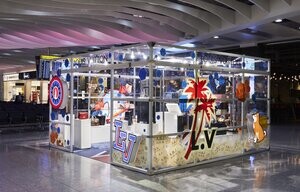Experiences are beginning to take over the retail space and for luxury brands this is an unparalleled opportunity.
As we walk through airports every day we can see that the experience of shopping in travel retail is becoming as important as the actual purchases – if not more so.
Every successful store is now filled with stands and displays which offer shoppers the chance to interact with the products. For travellers this an opportunity to discover something new or indulge in a moment of entertainment while they wait for their flight. For brands and retailers it creates the chance to make an extra sale or increase the size of the basket. With digital putting the pressure on pricing and ease of purchase, experience is becoming the golden ticket for physical stores.
It is set to get more important too. Recently Westfield, which operates shopping malls worldwide and has a strong travel retail presence in America predicted that experiential account for 50% of space in retail stores by 2025.
With digital putting the pressure on pricing and ease of purchase, experience is becoming the golden ticket for physical stores.
While many may see this as a loss of potential space for stock or sales, for luxury brands it is almost the opposite. The best examples of experiential retail from luxury brands in the TR market today are not created by large activations, but stores which become a part of the brand experience in themselves.
In this experiential market, pop-ups are the gold standard for luxury companies, creating the opportunity to craft a space which reflects the brand and its message from the moment shoppers arrive.
The luxury travel retail shopper is less looking for gimmicks than for an experience which reflects the money they are set to spend. A walk through Heathrow’s Terminal 5, which offers one of the top luxury shopping opportunities, presents a perfect example. Here, monobrand stores all capture the distinct characteristics of their brand. It draws the eye and lifts the concourse.
Our client Moncler are now well established in the travel retail market, and their new outlets are a perfect example of this, each imbued with a distinct aesthetic and atmosphere, which is reflected from the presentation of products and staff to the décor and signage.
The opportunity to create premium brand experiences through pop-ups is huge, and under-utilised.
Indeed, for luxury brands, whose character is well established and will be part of the attraction for potential shoppers, instore activations should be a seamless part of that identity, rather than standout centrepieces.
Multibrand duty free stores face the challenge of managing space for different products and experiences, but for luxury brands control of the space is absolutely vital. The recent work in the domestic market by Moncler and their Genius pop-ups show what is possible when space is made available and used properly.
The opportunity to create premium brand experiences through pop-ups is huge, and under-utilised. Some airports have enjoyed success by using digital games to bring life to areas of the airport which are otherwise without purpose.
Imagine the benefits if some of those areas could be turned into luxury boutiques, which catch the attention of passing shoppers, draw in those seeking out high-end brands and elevate the airport experience. That would be a way to dedicate space to both experience and retail without losing out on either and it is something which only luxury brands can offer.



